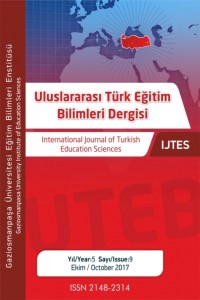Abstract
Nowadays,with the mobile devices becoming widespread, such processes as individual learning, place and time independent learning, aiming to access information, have emerged in the public. In order to be able to access information when needed, the significance of the mobile devices has increased. With these devices, learning activities of people have become more useful and faster. Mobile applications are required in order to access information swiftly with the mobile devices. Thanks to mobile applications, people can gather information about anything they don’t have any idea or they can improve themselves. As mobile applications appeal to many sense organs, permanent learning can be facilitated.
This study was carried out in order to design a quantification instrument to analyze usage of mobile applications for educational purposes by university students. In the development stage of the scale, studies on content validity, pre- application, construct validity and internal consistency were carried out. For content validity, opinions of 11 different academicians were analyzed. Pre-application was done in a sample of 21 people. For construct validity and internal consistency reliability studies, data of 408 university students was used. At the end of the study, the scale was comprised of 6-factor pattern. By looking at the items below each factor, the factors were named and the final state of the scale got shaped.
Keywords
References
- BESA, (2012). The future of Tablets and Apps in Schools. 03.06.2014 tarihinde http://www.besa.org.uk/documents/the-future-of-tablets-and-apps-inschools-toc/ adresinden erişilmiştir.
- Bulun, M., Gülnar, B. ve Güran, M. S. (2004). Eğitimde mobil teknolojiler. The Turkish Online Journal of Educational Technology, 3(2), 165-169.
- Büyüköztürk, Ş. (2011). Veri Analizi El Kitabı. (13. Baskı). Ankara: Pegem Akademi
- CISCO, (2014). Cisco Visual Networking Index: Global Mobile Data Traffic Forecast Update, 2013–2018. 03.06.2014 tarihinde http://www.cisco.com/c/en/us/solutions/collateral/service-provider/visual-networking-index-vni/white_paper_c11-520862.html adresinden erişilmiştir.
- de Waard, I. I. (2014). Using BYOD, Mobile Social Media, Apps, and Sensors for Meaningful Mobile Learning. Increasing Access, 113.
- Jackson, S., Ellis, H., Postner, L., Kurkovsky, S. ve Mustafaraj, E. (2012). Mobile application development in computing curricula. Journal of Computing Sciences in Colleges, 27(6), 123–125.
- Kinash, S., Brand, J. ve Mathew, T. (2012). Challenging mobile learning discourse through research: Student perceptions of Blackboard Mobile Learn and iPads. Australasian Journal of Educational Technology, 28(4), 639–655.
- Kukulska-Hulme, A. ve Traxler, J. (2005). Mobile learning: A handbook for educators and trainers. London: Routledge.
- McNamara, K. (2009). Mobile Applications in Agriculture and Rural Development: Framing the Topic, and Learning from Experience. World Bank, Washington, D.C. 09.06.2014 tarihinde
- http://siteresources.worldbank.org/EXTEDEVELOPMENT/Resources/Slides_McNamara_revised.pptx adresinden erişilmiştir.
- Peters, K. (2007). m-Learning: Positioning educators for a mobile, connected future. International Journal of Research in Open and Distance Learning, 8(2), 1–17.
- Purcell, K., Entner, R. ve Henderson, N. (2010). The rise of apps culture. Washington, DC: Pew Research Center’s Internet and American Life Project. 31.05.2014 tarihinde http://pewinternet.org/Reports/2010/The-Rise-of-Apps-Culture.aspx adresinden erişilmiştir.
Abstract
References
- BESA, (2012). The future of Tablets and Apps in Schools. 03.06.2014 tarihinde http://www.besa.org.uk/documents/the-future-of-tablets-and-apps-inschools-toc/ adresinden erişilmiştir.
- Bulun, M., Gülnar, B. ve Güran, M. S. (2004). Eğitimde mobil teknolojiler. The Turkish Online Journal of Educational Technology, 3(2), 165-169.
- Büyüköztürk, Ş. (2011). Veri Analizi El Kitabı. (13. Baskı). Ankara: Pegem Akademi
- CISCO, (2014). Cisco Visual Networking Index: Global Mobile Data Traffic Forecast Update, 2013–2018. 03.06.2014 tarihinde http://www.cisco.com/c/en/us/solutions/collateral/service-provider/visual-networking-index-vni/white_paper_c11-520862.html adresinden erişilmiştir.
- de Waard, I. I. (2014). Using BYOD, Mobile Social Media, Apps, and Sensors for Meaningful Mobile Learning. Increasing Access, 113.
- Jackson, S., Ellis, H., Postner, L., Kurkovsky, S. ve Mustafaraj, E. (2012). Mobile application development in computing curricula. Journal of Computing Sciences in Colleges, 27(6), 123–125.
- Kinash, S., Brand, J. ve Mathew, T. (2012). Challenging mobile learning discourse through research: Student perceptions of Blackboard Mobile Learn and iPads. Australasian Journal of Educational Technology, 28(4), 639–655.
- Kukulska-Hulme, A. ve Traxler, J. (2005). Mobile learning: A handbook for educators and trainers. London: Routledge.
- McNamara, K. (2009). Mobile Applications in Agriculture and Rural Development: Framing the Topic, and Learning from Experience. World Bank, Washington, D.C. 09.06.2014 tarihinde
- http://siteresources.worldbank.org/EXTEDEVELOPMENT/Resources/Slides_McNamara_revised.pptx adresinden erişilmiştir.
- Peters, K. (2007). m-Learning: Positioning educators for a mobile, connected future. International Journal of Research in Open and Distance Learning, 8(2), 1–17.
- Purcell, K., Entner, R. ve Henderson, N. (2010). The rise of apps culture. Washington, DC: Pew Research Center’s Internet and American Life Project. 31.05.2014 tarihinde http://pewinternet.org/Reports/2010/The-Rise-of-Apps-Culture.aspx adresinden erişilmiştir.
Details
| Journal Section | Articles |
|---|---|
| Authors | |
| Publication Date | October 31, 2017 |
| Submission Date | August 8, 2016 |
| Acceptance Date | October 29, 2017 |
| Published in Issue | Year 2017 Volume: 2017 Issue: 9 |


